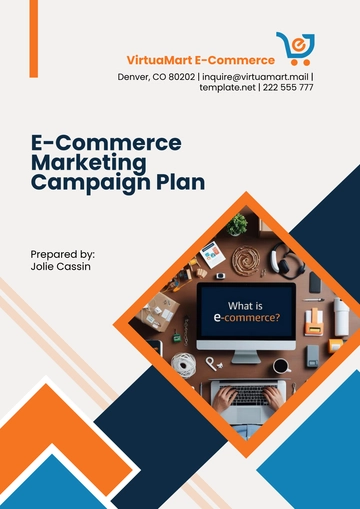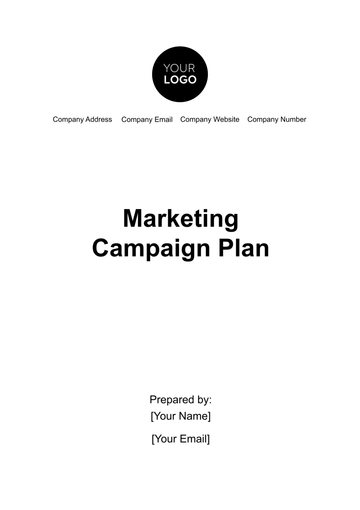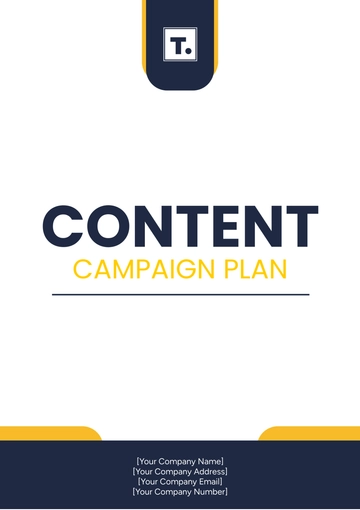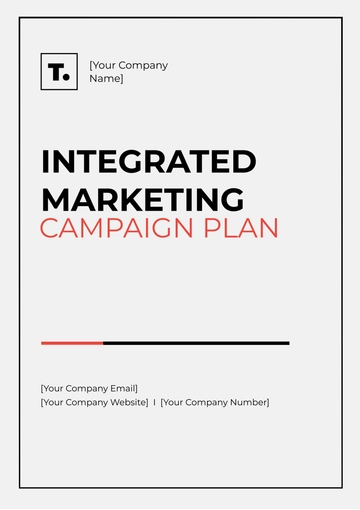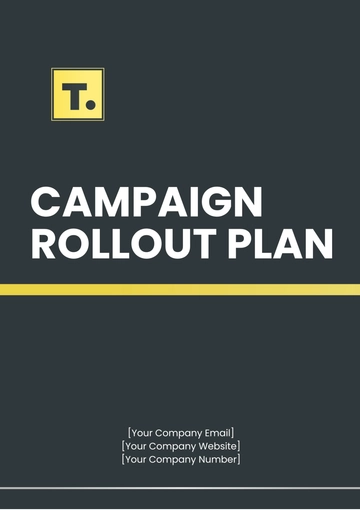Free Strategic Campaign Plan

I. Executive Summary
The Strategic Campaign Plan outlines long-term strategies and actions to achieve major business goals for [Your Company Name]. By focusing on strategic objectives, conducting a SWOT analysis, and allocating resources effectively, this plan aims to guide the organization toward sustainable growth and success.
II. Strategic Objectives
A. Business Growth
Expand market presence and increase market share by 20% over the next 5 years.
Drive revenue growth and profitability with an annual increase of 15%.
B. Brand Development
Enhance brand visibility, recognition, and reputation.
Establish the brand as a leader in the tech solutions industry.
III. Target Audience
A. Demographic Profile
Age: 25-45 years
Gender: All genders
Income Level: Medium to high
Location: Urban and suburban areas
B. Psychographic Profile
Interests: Technology, Lifestyle, Travel
Lifestyle: Busy professionals, Digital natives
Values: Quality, Authenticity, Innovation
IV. Competitive Analysis
An in-depth analysis of the competitive landscape is essential to identify opportunities and threats. This section includes:
Major Competitors
[Competitor A]
[Competitor B]
[Competitor C]
SWOT Analysis
A. Strengths
Strong brand reputation.
Innovative product/service offerings.
Experienced and talented team.
B. Weaknesses
Limited market reach.
Lack of diversification in product/service portfolio.
Reliance on a single distribution channel.
C. Opportunities
Emerging market trends and opportunities.
Potential for expansion into new geographic regions.
Strategic partnerships and collaborations.
D. Threats
Intense competition from established players.
Economic downturns and market fluctuations.
Regulatory changes impacting the industry.
V. Action Plans
A. Market Expansion
Conduct market research to identify growth opportunities.
Develop targeted marketing campaigns to penetrate new markets.
Establish strategic partnerships with local distributors or retailers.
B. Product Innovation
Invest in research and development to enhance existing products/services.
Launch new product lines or features to meet evolving customer needs.
Leverage customer feedback to drive product improvements.
C. Brand Awareness
Implement comprehensive branding and marketing strategies to increase brand visibility.
Launch integrated advertising campaigns across multiple channels.
Collaborate with influencers and industry experts to amplify brand messaging.
VI. Resource Allocation
A. Budget Allocation
Activity | Allocation |
|---|---|
Marketing | $50,000 |
Research & Development | $30,000 |
Sales & Distribution | $20,000 |
Technology | $10,000 |
B. Human Resources
Identify key personnel and allocate responsibilities.
Provide training and development opportunities to enhance skills.
Ensure adequate staffing levels to support campaign initiatives.
VII. Implementation Timeline
A detailed timeline will help ensure that all campaign activities are executed on time and within budget:
Month | Activity |
|---|---|
Month 1-2 | Research and Planning |
Month 3-4 | Creative Development |
Month 5-6 | Campaign Launch |
Month 7-12 | Monitoring and Optimization |
VIII. Measurement and Evaluation
A. Key Performance Indicators (KPIs)
Revenue Growth: Achieve a 15% increase in revenue over the first year.
Market Share: Capture 20% of the market share within the tech solutions sector.
Brand Awareness: Increase brand recognition by 25% among the target audience.
Customer Acquisition Cost (CAC): Maintain CAC below $200.
Return on Investment (ROI): Achieve an ROI of 30% on campaign spending.
B. Measurement Tools
Sales Analytics: Track revenue, sales volume, and customer acquisition metrics.
Brand Tracking Surveys: Conduct periodic surveys to measure brand awareness and perception.
Financial Reports: Analyze financial statements to assess profitability and ROI.
IX. Risk Management
A. Potential Risks
Market Changes
Budget Overruns
Operational Challenges
Negative Publicity
B. Mitigation Strategies
Regular Market Monitoring
Contingency Budget
Efficient Resource Management
Crisis Communication Plan
X. Conclusion
The Strategic Campaign Plan provides a roadmap for [Your Company Name] to achieve sustainable growth and success by aligning business objectives with strategic initiatives. By leveraging strengths, addressing weaknesses, and capitalizing on opportunities, we aim to position the company for long-term prosperity and market leadership.
- 100% Customizable, free editor
- Access 1 Million+ Templates, photo’s & graphics
- Download or share as a template
- Click and replace photos, graphics, text, backgrounds
- Resize, crop, AI write & more
- Access advanced editor
Ensure strategic success with Template.net's Strategic Campaign Plan Template. This editable and customizable template, available in our Ai Editor Tool, helps you create thorough strategies to achieve long-term goals.
You may also like
- Finance Plan
- Construction Plan
- Sales Plan
- Development Plan
- Career Plan
- Budget Plan
- HR Plan
- Education Plan
- Transition Plan
- Work Plan
- Training Plan
- Communication Plan
- Operation Plan
- Health And Safety Plan
- Strategy Plan
- Professional Development Plan
- Advertising Plan
- Risk Management Plan
- Restaurant Plan
- School Plan
- Nursing Home Patient Care Plan
- Nursing Care Plan
- Plan Event
- Startup Plan
- Social Media Plan
- Staffing Plan
- Annual Plan
- Content Plan
- Payment Plan
- Implementation Plan
- Hotel Plan
- Workout Plan
- Accounting Plan
- Campaign Plan
- Essay Plan
- 30 60 90 Day Plan
- Research Plan
- Recruitment Plan
- 90 Day Plan
- Quarterly Plan
- Emergency Plan
- 5 Year Plan
- Gym Plan
- Personal Plan
- IT and Software Plan
- Treatment Plan
- Real Estate Plan
- Law Firm Plan
- Healthcare Plan
- Improvement Plan
- Media Plan
- 5 Year Business Plan
- Learning Plan
- Marketing Campaign Plan
- Travel Agency Plan
- Cleaning Services Plan
- Interior Design Plan
- Performance Plan
- PR Plan
- Birth Plan
- Life Plan
- SEO Plan
- Disaster Recovery Plan
- Continuity Plan
- Launch Plan
- Legal Plan
- Behavior Plan
- Performance Improvement Plan
- Salon Plan
- Security Plan
- Security Management Plan
- Employee Development Plan
- Quality Plan
- Service Improvement Plan
- Growth Plan
- Incident Response Plan
- Basketball Plan
- Emergency Action Plan
- Product Launch Plan
- Spa Plan
- Employee Training Plan
- Data Analysis Plan
- Employee Action Plan
- Territory Plan
- Audit Plan
- Classroom Plan
- Activity Plan
- Parenting Plan
- Care Plan
- Project Execution Plan
- Exercise Plan
- Internship Plan
- Software Development Plan
- Continuous Improvement Plan
- Leave Plan
- 90 Day Sales Plan
- Advertising Agency Plan
- Employee Transition Plan
- Smart Action Plan
- Workplace Safety Plan
- Behavior Change Plan
- Contingency Plan
- Continuity of Operations Plan
- Health Plan
- Quality Control Plan
- Self Plan
- Sports Development Plan
- Change Management Plan
- Ecommerce Plan
- Personal Financial Plan
- Process Improvement Plan
- 30-60-90 Day Sales Plan
- Crisis Management Plan
- Engagement Plan
- Execution Plan
- Pandemic Plan
- Quality Assurance Plan
- Service Continuity Plan
- Agile Project Plan
- Fundraising Plan
- Job Transition Plan
- Asset Maintenance Plan
- Maintenance Plan
- Software Test Plan
- Staff Training and Development Plan
- 3 Year Plan
- Brand Activation Plan
- Release Plan
- Resource Plan
- Risk Mitigation Plan
- Teacher Plan
- 30 60 90 Day Plan for New Manager
- Food Safety Plan
- Food Truck Plan
- Hiring Plan
- Quality Management Plan
- Wellness Plan
- Behavior Intervention Plan
- Bonus Plan
- Investment Plan
- Maternity Leave Plan
- Pandemic Response Plan
- Succession Planning
- Coaching Plan
- Configuration Management Plan
- Remote Work Plan
- Self Care Plan
- Teaching Plan
- 100-Day Plan
- HACCP Plan
- Student Plan
- Sustainability Plan
- 30 60 90 Day Plan for Interview
- Access Plan
- Site Specific Safety Plan






